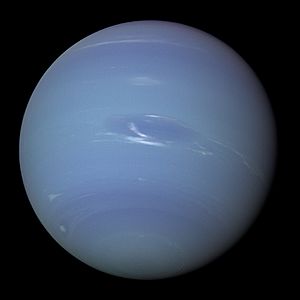Ice giant facts for kids

An ice giant is a huge planet mostly made of elements heavier than hydrogen and helium. These elements include oxygen, carbon, nitrogen, and sulfur. In our Solar System, we know of two ice giants: Uranus and Neptune.
Contents
What are Ice Giants?
Scientists used to group all giant planets together. But in the 1990s, they realized that Uranus and Neptune are special. They are different from Jupiter and Saturn. This is why they got their own name: ice giants.
When these planets first formed, the materials inside them were solid. Today, the water in Uranus and Neptune is not frozen ice. Instead, it's a special kind of fluid called a supercritical fluid. This means it acts like both a liquid and a gas at the same time.
What are "Ices"?
In space science, the word "ice" means certain chemicals that freeze easily. These chemicals are called volatiles. They freeze at temperatures above about -279 degrees Fahrenheit (-173 degrees Celsius).
Examples of these "ices" are water, ammonia, and methane. Water freezes at 32 degrees Fahrenheit (0 degrees Celsius). Ammonia freezes at -110 degrees Fahrenheit (-79 degrees Celsius). Methane freezes at -296 degrees Fahrenheit (-182 degrees Celsius).
How are Ice Giants Different?
Ice giants are different from gas giants like Jupiter and Saturn. Ice giants are only about 20% hydrogen and helium by mass. This means most of their mass comes from other, heavier elements.
In contrast, gas giants like Jupiter and Saturn are mostly hydrogen and helium. More than 90% of their mass is made up of these two light elements. This key difference makes ice giants a unique type of planet.
Images for kids
-
These cut-aways illustrate interior models of the giant planets. The planetary cores of gas giants Jupiter and Saturn are overlaid by a deep layer of metallic hydrogen, whereas the mantles of the ice giants Uranus and Neptune are composed of heavier elements.
See also
 In Spanish: Gigante helado para niños
In Spanish: Gigante helado para niños


